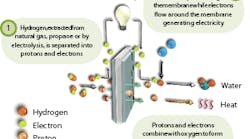As of New Year’s Day, a company not widely known in the ground support equipment industry officially starts work to develop a promising alternative to power electric tractors.
That’s the official start date that Plug Power Inc., Latham, NY, a fuel cell company started in 1997, begins a project funded with a $2.5 million grant from the Department of Energy to retrofit 15 Charlatte CTGE cargo tractors with its brand of hydrogen-powered fuel cells.
After some R&D, the tractors will be put to the test on the ramp by no less than FedEx at two airports, including its busy Memphis headquarters.
Plug Power may be a new name to Ground Support Worldwide readers, but it’s no stranger to FedEx since the company brings along a proven track record with its fuel cells used for material handling applications.
Two years ago, the DOE awarded FedEx Freight a multimillion-dollar grant under the American Recovery and Reinvestment Act to deploy fuel cell forklifts at its Springfield, MO warehouse.
Together with Plug Power and other partners in the funding, FedEx eventually installed 35 hydrogen fuel cell systems as lead battery replacements for a complete fleet of electric lift trucks at the Missouri service center. A permanent hydrogen fueling infrastructure was also built, including hydrogen storage and two indoor dispensing stations.
Although early sales were spurred by government money, Plug Power says its subsequent sales from the material handling industry have been earned without any financial incentives. To date, Plug Power says it has some 3,000 GenDrive fuel cells powering material handling equipment at 30 customer locations accumulating more than 8.5 million hours of runtime.
“There’s no going back to batteries for these customers,” says Reid Hislop, vice president of marketing and investor relations for Plug Power. “In cases where customers are planning to build new facilities, there are no allocations for charging stations and any extra room is used for additional business operations.”
Water is about the only emission produced by hydrogen-powered fuel cell equipment so H2 certainly qualifies as a bona-fide source of green energy. Plug Power, however, doesn’t sell energy efficiency as much as good old-fashioned company efficiency.
“The story for us is about improving productivity,” Hislop adds. “A company like FedEx is not going to invest in this type of energy technology unless its executives know they can improve performance and save money.”
Or companies such as Walmart, Sysco, P&G and Mercedes to name a few of Plug Power’s other customers that currently use its fuel cells in material handling equipment at warehouse locations around the country.
For Hislop, improvements can come down to minutes that quickly add up fast.
“If a rechargeable lead acid battery means a forklift is taken out of use for 20 minutes,” Hislop explains, “than added up over a 100-lift fleet, you end up with significant amount of cost.”
According to the company, refueling its fuel cells takes less than two minutes.
“It’s very much like putting gas in your car,” Hislop adds, “and that lift is ready to go at full speed for another shift.”
NEW MARKET
Moving into the GSE market seems an obvious choice to the company. At stake are not just cargo tractors, but all other electric GSE that predominately use batteries.
At this point, Plug Power’s work with the FedEx GSE project remains in its very early stages. What it’s developed as a simple drop in fuel cell to replace batteries inside MHV simply won’t be dropped into the 15 Charlatte tow tractors.
“We know that we’ll need to upsize our fuel cells to provide the proper amount of power and voltage to the equipment,” says Jim Petrecky, director of business development for Plug Power.
Since forklifts are typically working inside, Plug Power also needs to factor in all types of weather for the FedEx tractors. However, Petrecky adds that some his company’s customers operate MHV inside freezers all day long so there already is some freeze protection built into the current line of Plug Power fuel cells.
Temperatures, however, shouldn’t be too much of a factor for the FedEx GSE project since 10 of the tractors will be stationed in Memphis, TN and the remaining five will be used in Oakland, CA. Still, Petrecky says the fuel cells will need to be “ruggedized” to take into account rain, wind and anything else Mother Nature might send out on the ramp in Tennessee and California.
The promise of using hydrogen fuel cells to power GSE has been told in these pages before, and such articles always start out, well, promising. The Plug Power initiative, however, has two advantages that could make this source of power play out.
READY SUPPLY
Hydrogen has about three times more “energy content” by weight than gasoline, which is a good thing. But hydrogen, at least liquid hydrogen, has four times less energy content than gasoline, which is a bad thing.
What that has typically meant is vast storage for hydrogen on site, which few want, or an expensive alternative that has even fewer takers at least for our on-the-go, 24/7 industry
“Half of the cost of hydrogen is typically in its transportation,” Petrecky adds.
Enter another new name to most Ground Support Worldwide readers.
“The whole viability of converting to hydrogen fuel cells hinges on the availability of hydrogen at a reasonable cost,” says Gus Block, director of marketing and government affairs for Nuvera, based in Billerica, MA, and also a partner with Plug Power in the FedEx GSE project.
Nuvera has been focusing on that availability issue since its start in 2000, particularly at relatively low-use sites. The company’s PowerTap, a reformer that turns natural gas and water into hydrogen will be installed at the two FedEx airports as part of the GSE project.
“Nuvera eliminates the transportation issue,” Patrecky adds. “Natural gas is everywhere.”
CHEAP SUPPLY
By packaging fuel cell replacements with Nuvera’s small-scale, onsite production facilities that use natural gas as its primary feedstock for hydrogen production, the FedEx GSE project takes on a different appearance than other hydrogen power stories.
Rather than huge storage and expensive infrastructure that tags along, Nuvera’s system already takes advantage of much of the natural gas pipelines that already exist.
Nuvera calls its PowerTap an “appliance,” that takes up a very small footprint. The company also has an interesting business model in that users simply enter into a contract with Nuvera – which essentially sees itself as a hydrogen supplier.
“We sell hydrogen by the molecule,” Block adds, “so there is no capital outlay on the part of the end-user.”
There’s also an interesting energy story happening in the United States that Block says has “decoupled” the price of natural gas from the price of oil. Typically, natural gas reserves are found along with oil reserves. That type of natural gas is referred to as “wet gas.” But shale gas, referred to as “dry gas,” has turned the energy markets upside down with natural gas prices reaching lows while the oil prices remain high.
America might has well be known as the Saudi Arabia of dry gas. According the Energy Information Administration, the United States has reserves on the order of 100 times annual consumption rates.
“That’s created a window of opportunity for the increased use of natural gas as a transportation fuel,” Block says.
In the new year ahead, we’ll check in with Plug Power to see what progress they make.








